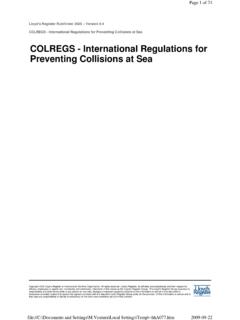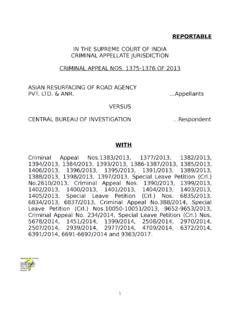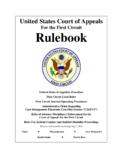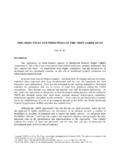Transcription of IN THE U.S. NAVY-MARINE CORPS COURT OF CRIMINAL …
1 IN THE NAVY-MARINE CORPS COURT OF CRIMINAL APPEALS WASHINGTON NAVY YARD WASHINGTON, BEFORE ROLPH HARTY KELLY UNITED STATES v. Derek R. UNDERHILL Seaman (E-3), Navy NMCCA 200700144 Decided 9 August 2007 Sentence adjudged 19 October 2006. Military Judge: Bengtson. Staff Judge Advocate's Recommendation: LT Hoyt, JAGC, USN. Review pursuant to Article 66(c), UCMJ, of General COURT -Martial convened by Commander, Naval Forces, Japan. LT HEATHER CASSIDY, JAGC, USN, Appellate Defense Counsel LT JUSTIN E. DUNLAP, JAGC, USN, Appellate Government Counsel LT FRANK L. GATTO, JAGC, USN, Appellate Government Counsel AS AN UNPUBLISHED DECISION, THIS OPINION DOES NOT SERVE AS PRECEDENT.
2 HARTY, Senior Judge A military judge sitting as a general COURT -martial convicted the appellant, contrary to his pleas, of carnal knowledge and sodomy with a child more than 12 years but less than 16 years of age, in violation of Articles 120 and 125, Uniform Code of Military Justice, 10 920 and 925. His sentence included a bad-conduct discharge, confinement for six months, and reduction to pay grade E-1. The convening authority (CA) approved the sentence as adjudged. We have reviewed the record of trial, the appellant's two assignments of error claiming that the record of trial is not verbatim and that the staff judge advocate (SJA) erred by not addressing legal errors raised by the 1 The appellant asserts the SJA erred by not addressing the legal errors raised by the appellant after service of the SJA s recommendation (SJAR).
3 We disagree. The SJA is supposed to use the record of trial in making his recommendation even though he is not required to review the record for legal error. RULE FOR COURTS-MARTIAL 1106(d)(1) and (4), MANUAL FOR COURTS-MARTIAL, UNITED STATES (2005 ed.). If the record is reviewed for legal error, the SJA need We have also 2 considered the Government's answer, and the appellant s reply. We conclude that the findings and sentence are correct in law and fact and that no error materially prejudicial to the substantial rights of the appellant was committed. Arts. 59(a) and 66(c), UCMJ. Background The appellant, a 20-year-old Sailor from a small town in Florida, was assigned to a ship home ported in Yokosuka, Japan.
4 A 15-year-old Navy dependent, RW, initiated contact with the appellant through a website on The appellant and RW agreed to meet and struck up a friendship. Two weeks into that friendship, they began to engage in sexual activity including oral, anal, and vaginal sex. When RW thought she might become pregnant from one incident of sexual activity, the appellant took her to the base hospital so she could get a morning after pill. Law enforcement was notified while the appellant and RW were at the hospital, statements were taken, and the appellant was charged with CRIMINAL acts against RW. After trial but before the record was authenticated, the COURT reporter discovered that one of the audio tapes from the trial had been erased.
5 That tape contained all or part of the testimony given by four defense witnesses during the presentence hearing. Those four witnesses included the appellant s mother, sister, and an expert witness, all of whom testified in person; and the appellant s high school teacher, who testified by telephone. The military judge ordered a post-trial Article 39(a), UCMJ, session in order to conduct an RULE FOR COURTS-MARTIAL 1102, MANUAL FOR COURTS-MARTIAL, UNITED STATES (2005 ed.) hearing to recreate the lost testimony. During that hearing, the appellant s mother recreated her testimony by telephone and the expert witness testified in person. The remaining two witnesses were not available, according to the trial defense counsel, and their testimony was only state in summary fashion whether any legal error requires corrective action.
6 1106(d)(4). The SJAR contains the SJA s conclusion that there are no legal errors within the record that require corrective action. SJAR of 25 Jan 2007. Although the SJA was obligated to comment on the submitted allegations of legal error, we do not find prejudice to the appellant from the SJA s failure. First, all legal issues subsequently raised by the appellant deal with issues that were fully litigated on the record; therefore, each alleged legal error was previously reviewed by the SJA. We do not see how the appellant is prejudiced by the SJA s failure to repeat his conclusion in an SJAR addendum. Second, the appellant did not suffer prejudice because since the legal issues raised are without merit, they would neither result in a favorable SJA recommendation for corrective action, nor result in corrective action by the CA.
7 See United States v. Green, 44 93, 95 ( 1996)(an appellate COURT may determine if the accused has been prejudiced by the SJA s failure to comment on submitted legal error by testing whether the alleged error has any merit and would have led to a favorable recommendation by the SJA or corrective action by the convening authority)(citing United States v. Hill, 27 293, 297 ( 1988)). 3 summarized by the trial counsel and trial defense counsel. Appellate Exhibits LXX and LXXI. Incomplete Record of Trial For his first assignment of error, the appellant claims that the record of trial is not verbatim and that the missing verbatim testimony, objections, and COURT rulings, are substantial omissions creating an unrebutted presumption of prejudice.
8 Appellant s Brief of 13 Apr 2007 at 8. We disagree. 1. The law Whether a record of trial is incomplete, is a question of law which we review de novo. The requirement that a record of trial be complete and substantially verbatim in order to uphold the validity of a verbatim record sentence is one of jurisdictional proportion that cannot be waived. United States v. Henry, 53 108, 110 ( 2000)(citing United States v. Gray, 7 296 ( 1979)); see 1103(b)(2)(B)). Whether an omission is substantial can be a question of quality as well as quantity. United States v. Lashley, 14 7, 9 ( 1982). Substantial omissions render a record of trial incomplete, raising a presumption of (citing United States v.
9 McCullah, 11 234, 237 ( 1981)). Insubstantial omissions do not raise a presumption of prejudice or affect the record's characterization as a complete one. Id. at 8 3 2 See, , United States v. Stoffer, 53 26, 27 ( 2000)(three defense sentencing exhibits not otherwise described in the record); United States v. McCullah, 11 234, 237 ( 1981)(a letter of dishonor in a worthless check case used to show mens rea); Gray, 7 at 298 (unrecorded sidebar conferences involving the admission of evidence); United States v. Sturdivant, 1 256, 257 ( 1976)(argument concerning COURT member challenges); United States v. Seal, 38 659 ( 1993)(videotapes showing the accused flying during Desert Shield/Storm, which was admitted during the sentencing portion of trial).
10 3 See, , United States v. Barnes, 12 614, 615 ( 1981)(appellate exhibits consisting of questionnaires completed by the COURT members when those exhibits were not offered and no ruling was based on the content of those questionnaires); United States v. Burns, 46 492, 498 ( 1972)(a topographical chart depicting the location of a victim's body when that location was clearly established by testimony and other exhibits); United States v. White, 52 713, 715 (Army 2000) Henry, 53 at 111. (a defense exhibit consisting of a videotape used as demonstrative evidence of the interior configuration of the appellant's car when that information was presented by other means and was not in dispute); United States v.













